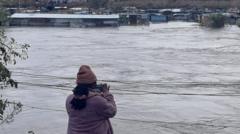Storm Eowyn wreaked havoc across Ireland, Scotland, and northern England, causing record-breaking winds that left over 700,000 people without power. The storm is characterized by gusts reaching up to 114 mph, leading to significant travel disruptions and widespread warnings from meteorological agencies.
Storm Eowyn Rages Across Ireland, Leaving Hundreds of Thousands in the Dark

Storm Eowyn Rages Across Ireland, Leaving Hundreds of Thousands in the Dark
Powerful winds and adverse weather disrupt travel and power supply, affecting nearly a third of Ireland's electricity customers.
Heavy winds generated by Storm Eowyn have left a staggering 715,000 customers without power in Ireland, representing almost a third of the total electricity consumers in the nation. The storm hit on Friday, causing chaos and stressing travel networks across Ireland, Scotland, and the northern parts of England.
As per the predictions from the Irish Meteorological Service, strong gales swept across the region throughout the day, with the potential for even more extreme weather conditions impacting areas in Northern Ireland, southern Scotland, and parts of England and Wales. Rare gusts of winds clocking up to 70 miles per hour were officially forecasted, with coastal areas around the Irish Sea and southwestern Scotland bracing for wind speeds that could reach up to 100 mph.
By 5 a.m. Friday, Mace Head, County Galway, recorded a whopping gust of 114 mph, a new record that surpassed the previous high set in 1945. The state-owned electricity provider, ESB Networks, confirmed that the extensive outage was due to the storm’s ferocity.
In addition to the damaging winds, rain showers and prolonged periods of rainfall are anticipated across northern Ireland, while regions in Scotland are at risk for potential hail and snow on higher grounds. The alert from Britain’s Meteorological Office characterized the conditions as "very dangerous,” predicting widespread disruptions and significant impacts on day-to-day activities.
Public transportation facilities are feeling the impact, with Northern Rail advising travelers to avoid journeys on Friday and Saturday due to severe interruptions related to the storm. Airports are facing challenges as well; Belfast International Airport warned passengers to stay indoors on Friday thanks to intermittent power losses while flights faced grounding across airports in both Ireland and Britain.
The unusual strength of Storm Eowyn is attributed to a potent jet stream that contributed to its development. Typically, the jet stream travels at speeds of 190 to 220 mph, but this week, it has escalated to speeds of 260 mph, supplementing the storm's intensity. Given that Eowyn is the most vigorous storm to impact Ireland since 2017—when one of the region's most notorious storms caused fatalities—residents are urged to remain vigilant and prioritize safety.





















